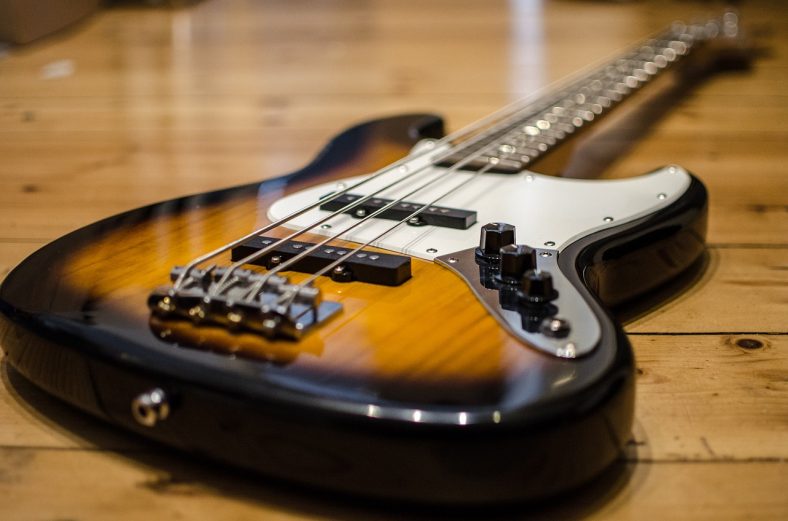4 String vs 5 String Bass – Which One Should You Get?

If you are a bass player or thinking of learning how to play bass, then one of the most important decisions you will need to make is what kind of bass to buy. A bass guitar is an investment and you need to weigh the pros and cons of both before you make a choice.
Different basses are designed for different genres of music and style of playing. Let us take a look at some of the features of 4-string and 5-string basses and which one you should get:
Contents
What Is The Difference Between A 4-String And A 5-String Bass?
A 4-string bass has 4 strings that are generally tuned to E-A-D-G on a standard E-tuning. A 5 string bass has an additional string. This can either be a low B or a high C. The tuning, thus, is B-E-A-D-G or, E-A-D-G-C.
- A 5-string bass offers more an added low range. This can be great for musicians who play the different subgenres of metal and are looking for lower tunings. However, the necks of 5-string basses are thicker than 4-string ones. Beginners may find them a lot harder to play.
- 4-string basses are easier to play. This means that you can pick up playing techniques such as fingerstyle, slapping, and tapping on the instrument with more ease in comparison to 5-string basses. But there is a limit in terms of what notes you have access to. 5-string basses give you more choices.
The Advantages Of A 4-String Bass:
- Since these are the more conventional basses, there are many varieties you can choose from depending on your budget. Whether you are a beginner, intermediate or professional bass player, there is a bass for everyone.
- The guitars generally have thinner necks compared to 5-stringed basses. This makes playability easier, especially if you are a beginner.
- The body of a 4-string is lighter than a 5-string. It is known that basses are already heavier than guitars. When an instrument is too heavy, it can often be difficult to play it.
The Advantages Of A 5-String Bass:
- There is scope for more playability in terms of notes. This allows you to play unique arpeggios or notes when playing scales and runs.
- A 5-string is a lot more versatile and the added string enriches your tone when you are playing one.
- You get easier access to more tuning options and not just a drop-D tuning.
Is A 4 Or 5 String Bass Better?
This depends entirely on what kind of music you want to play and what your playing style is like.
Those who play rock n’ roll, funk, or even pop will find a 4-string more useful whereas metal musicians or solo bass players will find 5-strings more apt for their form of music.
If your music needs the extra lower note or if you want more note options then a 5-string is for you.
If you are looking to hold a groove and play a versatile bass, then you are better suited for a 4-string.
Can You Slap On A 5-String Bass?
Yes.
Generally, the technique of slapping requires practice. If you put in enough time and effort then you should be able to slap on a 5-string bass. The legendary bass player, Victor Wooten often uses slap, tap, and pizzicato techniques on his 5-string bass.
However, if you are a beginner then you may find it easier to slap on a 4-string bass.
5 String VS 6 String Bass
Many people may not know but in addition to 5-string basses, there are also 6-string basses that should not be confused with guitars.
Although they may share the same number of tuning knobs, they sound nothing like a guitar. 6-string basses typically have thick necks and can have either active or passive pickups.
In some instances, depending on what kind of music you want to play, a 6-string might be better suited for you than a 5-string bass.
What Is A 6-String Bass?
A 6-String bass has two additional strings to add one extra high and one low note. The tuning is generally B-E-A-D-G-C. This is because basses are tuned in fourths, unlike guitars where the tuning is generally in fourths but one string is in thirds.
Advantages Of A 6-String Bass:
- 6 String basses offer even more tonal options are if you are a solo bass player then these basses are definitely for you. You get access to a wider palette of notes and playability and play higher as well as lower notes simultaneously.
- Playing chords is much easier. You can hold chords instead of playing just the octave notes. This will let you add color to your playing.
- These basses are generally very durable and investing in one would mean that you do not have to worry about replacing it in a few years.
Disadvantages Of A 6-String:
- You will need to learn how to play this instrument. It takes time to get used to a 6-string even for professionals because the space in between the strings is narrower than a regular 4 or 5 string. Also, these are not beginner-friendly.
- 6-string basses are generally expensive and harder to source than 4 or 5-string ones.
- In terms of weight, they are heavy and you will often find it difficult to play one for long periods of time standing up.
Summary
A bass is easily one of the most beautiful sounding instruments and forms the backbone of musical compositions. This is something that both 4-string and 5-string bass players can agree on.
Professional musicians often make use of both, depending on what they are playing. A lot of times, they start on a 4-string when they start learning how to play the instrument and then invest in a 5-string when they have sufficient skills.
There is a right bass out there for you. If you are still unsure about which one to get, you should visit your local music store and play around with both of them. Ultimately, it comes down to which one you feel the most comfortable playing and one that fits nicely within your budget.





